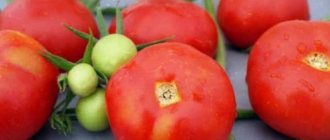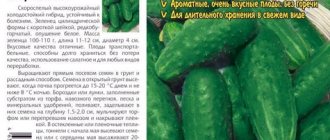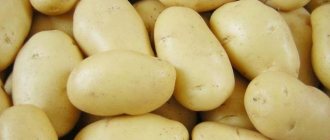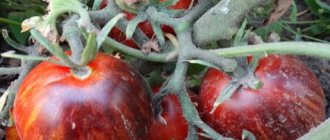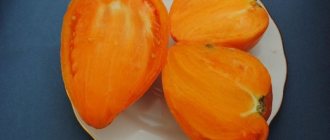Tomato Idol: description of the variety
The tomato variety Kumir is distinguished, first of all, by its high yield, as well as a long fruiting period. On average, from 1 sq. m you can get about 14-18 kg of fruit. You can enjoy tomatoes from the garden until late autumn.
Fruit characteristics, yield
This is a standard variety, that is, the plant has no branches. Reaches 1.8-2 m in height. The fruits are large - weighing on average 400 g, bright red, round. The tomato is divided into 4-6 chambers. It has 5% dry matter, which makes the variety very juicy.
It is recommended to plant 3 plants per 1 square meter. m. One plant, with proper care, produces 4-6 kg of tomatoes. Thus, the yield per 1 sq. m can be up to 18 kg.
general characteristics
It is recommended that gardeners who prefer large tomatoes pay attention to this variety. In addition, the “Idol” variety is distinguished by high fertility. Brought out in Russia, not new, entered into the state register back in 1997 and can be grown both in greenhouses of various types and in open soil.
Morphological characteristics
- A distinctive feature of the variety is its ability to bear fruit almost all autumn, until cold weather, even when all other varieties have long stopped producing fruit.
- The plant is determinate and standard, tall. The height of the bush can reach about 1.80 - 2.00 m. Experienced vegetable growers recommend transferring growth to a side shoot, then the height of the bush will be 1.5 - 1.7 m, and the yield increases significantly.
- Mid-early ripening tomatoes. From the moment of planting the seed until the fruiting period, on average, 100 - 110 days pass.
- The variety has good resistance to various diseases that are characteristic of the Solanaceae family. The only disease most common in this tomato is blossom end rot. But it can be avoided if you properly care for your tomatoes.
- Judging by numerous reviews, you can collect 4.5 - 6 kg from one bush. It is recommended to plant no more than 3 bushes per 1 m2, then the average yield will be about 18 kg. The result is quite good.
- Universal application. In general, it is not suitable for pickling, as it is very large in size. But juices and purees are very tasty, and are also used in salads and simply fresh.
Description of fruits
- The tomatoes are round in shape, bright red in color, average weight is approximately 400 grams. The surface of the top layer is smooth, the skin is shiny and smooth.
- Fruiting is extended. It's been going on for a long time. The taste is very juicy and sweetish - sour, the flesh is soft, not fibrous.
- One tomato usually has 4 - 6 chambers. The fruits contain dry matter - 5%. After harvest, tomatoes retain their density and freshness for a long time and can be transported over long distances.
Advantages
“Idol” has a number of advantages that make the variety very popular and famous among gardeners and tomato lovers:
- the ability to harvest for a long time;
- taste qualities do not change even in the last stages of ripening;
- high level of productivity;
- resistance to major viruses and infections;
- unpretentiousness and undemandingness in cultivation;
- large fruit size and excellent taste.
Flaws
There are some shortcomings inherent in this variety. They are not fundamental, but such features of tomatoes should be taken into account.
- During the ripening period, the plant is quite capricious and very selective in different feedings.
- The tissues of the stems are quite weak, so it is necessary to tie them up and provide support from the very beginning of growth.
- Those who like to preserve whole tomatoes in this case will not be able to accomplish their plans, since the tomatoes are large and do not fit into jars. Can only be preserved in pieces or in salads.
How to grow seedlings
Let's consider the main stages of growing Kumir tomato seedlings.
Seed preparation
First of all, you need to soak the seeds in a solution of potassium permanganate for 15 minutes to disinfect them. Then rinse and place in a solution of 1 liter of water and 10 g of natrophoska for a day. This will stimulate better growth and development of seedlings. Before planting, the seeds should lie in moisture for 1-2 days. This promotes their germination.
Container and soil
Typically, wooden boxes or plastic containers are used for planting seedlings. The prepared soil is placed in the container. It should have neutral acidity. A good material would be soil mixed with peat or humus.
Sowing
Sowing takes place in the second half of March. In the prepared soil, make depressions of at least 1 cm at a distance of 1 cm from each other. Seeds are placed there and sprinkled with earth.
Next, the seedlings need to be watered, cover the container with film or glass and place in a warm (at least 23 degrees) and bright place.
Growing and care
The seedlings are watered as they dry out. 10 days after planting, the first shoots can be seen. This means it's time to move the seedlings to a cooler, but also well-lit place. The film or glass is removed for literally 2 hours, and then the seedlings are covered with them again.
It is recommended to take her out into the fresh air (balcony, veranda) so that she gets used to outdoor conditions. As soon as 3-4 developed leaves appear on the sprouts, the seedlings can be transplanted into open ground or a greenhouse.
Timing and sowing
When to plant tomatoes as seedlings, in what month? The timing of sowing depends on the planned date of transferring the seedlings to the ground. If you plan to plant the plants in mid-May, then sowing the seeds is recommended in early March. Typically, seedlings are planted at the age of 60 days. A week is added to this period for seedlings: in total, about 65-67 days will pass from the time of sowing to the planting date.
Knowing how many days it takes for tomatoes to sprout and at what age the seedlings are planted, you can calculate the sowing dates for each region.
Seeds are sown in seedling boxes or individual containers up to eight centimeters deep. The container is filled 2/3 with soil. In the boxes, a sowing pattern of 2x2 cm is maintained; for individual plantings, a depression of about 2 cm is made in the center of the container and one seed is placed there. To speed up germination, it is recommended to cover the crops with film or glass.
In a week, sprouts will appear. As soon as all the seeds hatch, you need to remove the glass. After two weeks, the first fertilizing is applied. Due to the limited volume of the container, it is recommended to use complex fertilizers diluted strictly according to the instructions.
As soon as two true leaves appear on the plants, pick them. If this cannot be done, then the seedlings are covered with soil.
At the time of planting the seedlings, there should be a flower brush on it.
How to grow tomatoes
Let's take a closer look at the stages of growing Kumir tomatoes.
Landing
At the end of May - beginning of June, when the temperature is consistently high, the seedlings are planted in open ground. You can transfer them to the greenhouse a little earlier - in mid-May. The land for planting should be prepared in the fall: the soil should be fertilized with compost and ash. Plant no more than three bushes per 1 square. m.
Care
Proper care is the key to a large and tasty harvest. A photo of ripe tomatoes is shown below.
During disembarkation, it is important not to forget to put supports. During the formation of the stems, it is necessary to tie up the tomatoes, otherwise the plant will bend and die under the weight of the fruit.
Another important component of caring for Kumir tomatoes is pinching - the process of removing stepsons, which take all the nutrients and prevent the fruit from forming.
We must not forget about regular watering: on hot days it must be done every evening, and on cold days – once every 2-3 days is enough. It is necessary to ventilate the greenhouse if tomatoes are growing in it, so that increased humidity does not provoke the appearance of fungus. Timely weeding and loosening also help prevent the appearance of pathogenic bacteria.
Reference . Remember about feeding: the Kumir tomato variety responds well to mineral fertilizers.
Features of cultivation and possible difficulties
The Idol variety is quite unpretentious and does not require special care. Therefore, compliance with the usual rules of care is rewarded with a bountiful harvest. However, like any tomatoes, Idol is susceptible to certain diseases and pests.
Diseases and pests
The most common tomato disease is late blight. It appears as brown leaves, black stems and black spots on tomatoes. It can be removed using fungicides. If prevention and treatment with drugs did not help get rid of late blight, then the diseased plant must be disposed of as quickly as possible so as not to infect others with it.
Also, all gardeners who grow potatoes and tomatoes are aware of such a pest as the Colorado potato beetle . Usually it burrows into the soil for the winter, and in the spring it comes out and eats plants. Therefore, it is important to thoroughly prepare the soil before planting, which helps with loosening. You can also plant garlic or calendula next to the tomatoes.
These plants have a pungent odor that repels beetles. If the Colorado pest does attack the plant, it is better to remove the insects manually, since chemical treatment, although effective, is not environmentally friendly and can also harm humans.
Pest and disease control
Tomato Idol is resistant to many diseases. But if the rules of care are not followed, the following may appear on the bush:
- Top rot - appears when there is a lack of potassium and moisture. The disease can be recognized by the dark spots that appear on the tops of the fruit. Infected plants stop growing and developing, the fruits darken and rot. They fight the disease by adjusting the watering schedule and feeding the bush with potassium fertilizers.
- Late blight - appears on the plant in early autumn. Foliage and fruits become covered with dark spots, which grow without treatment and can completely destroy the crop. To preserve the harvest, healthy plants are treated with Barrier or Zaslon, and infected bushes are dug up and burned.
- Septoria blight is a fungal disease that affects the lower foliage. As a result, the plant becomes depleted, the leaf blade becomes covered with dark spots with a white core. Without treatment, the leaves turn brown, dry out and fall off, and the tomato plant dies over time. Treatment consists of treating the plant with a 1% solution of Bordeaux mixture.
- Cladosporiosis - appears as a result of waterlogged soil and high air humidity. The outer side of the leaf is covered with dirty yellow spots, and the inner side is olive green. Without treatment, the foliage turns black and dries out. An infected plant cannot be treated. It is dug up and burned, and the ground is treated with a weak solution of potassium permanganate, ash infusion or copper-containing preparations.
- Spider mites appear at high temperatures and humidity. It can be recognized by a thin web that covers the entire ground part. The pest feeds on the sap of the plant, as a result it becomes depleted, lags behind in development, and productivity decreases. You can get rid of the insect using folk remedies. The bush is sprayed with alcohol infusion, a decoction of dandelions, horseradish root
In order not to encounter difficulties and grow a strong and healthy plant, it is important to carry out preventive measures in a timely manner:
- watering with warm water as the soil dries;
- fertilizing with nitrogen and phosphorus-potassium fertilizers, strictly according to schedule;
- regular ventilation of the greenhouse;
- loosening the soil and removing weeds;
- timely disposal of diseased plants;
- compliance with crop rotation;
- Plant marigolds, calendula or herbs next to tomato bushes.
The nuances of growing in open ground and greenhouses
When choosing what soil to plant seedlings in, you need to keep in mind that future care of the plants depends on this. In a greenhouse, for example, the temperature is higher than in open ground. It must be ventilated and carefully monitor soil moisture. Also, if you treat tomatoes with chemical solutions, then in the greenhouse you need to do this especially carefully so as not to breathe in harmful fumes.
Be careful when pruning tomatoes: in a hot room, too much pruning of leaves causes the plant to overheat and subsequently dry out. However, despite such nuances, for northern latitudes, a greenhouse is the only suitable option for growing tomatoes. This will keep them warm.
Important ! Even in southern latitudes, tomatoes are not protected from precipitation and cold when they grow in open ground. This can greatly facilitate the work of watering tomatoes, but, on the other hand, excess moisture provokes the appearance of pathogenic fungi.
How to care for bushes - tips
- The main thing that cannot be ignored is the formation of the plant and pinching. Then young shoots will not take all the nutrients from the main stems.
- In more northern regions, it is recommended to remove all foliage located in the lower part of the bush before each fresh ovary. Leave a small number of leaves needed for photosynthesis.
- In such regions, it is better to use greenhouses and film shelters for growing. In the south, on the contrary, leave the leaves so that the plant does not get burned by the fruit under the strong scorching sun.
Harvesting and application
The Idol tomato ripens 100-110 days after the first shoots appear and bears fruit until late autumn. The fruits can be consumed in any form: canned, prepared salads from fresh vegetables, made tomato juice, prepared sauces.
The good thing about the idol is that it is not damaged during transportation and long-term storage, and also does not lose its taste during heat treatment.
Description of fruits
Tomato fruits are large, round in shape, red in color. They have a balanced sweet and sour taste with a bright tomato aroma. The weight of one fruit ranges from 300 to 500 grams, but there are also record holders. There are four to six seed chambers inside a tomato.
In cooking, the fruits are recommended for fresh consumption, preparing salads, and also for preserving whole fruits. Tomatoes have proven themselves well in the preparation of sauces and juices. Ripe tomatoes are stored for a long time and tolerate transportation well without losing their presentation.
Advantages and disadvantages of the variety
Thus, the idol tomato has many advantages:
- high productivity;
- long fruiting period;
- large fruits with good taste;
- lack of special rules for care.
However, there are some disadvantages:
- cannot grow without supports due to heavy fruits and relatively weak stems;
- Large fruits do not allow them to be preserved entirely.
Tomatoes Idol on video
If you grew Kumir tomatoes, please write whether you liked them or not. What was the yield and taste of the fruits like under your climatic conditions? How do you rate the disease resistance of this tomato? Briefly describe the advantages and disadvantages (pros and cons) of this tomato in your opinion. If possible, attach to the comment a photo of the entire bush as a whole or individual fruits that you grew. Thank you!
Your reviews of the Idol tomato and additions to the description will help many gardeners evaluate this variety and decide whether it is worth planting or not.
Farmer reviews
Gardening forums on the Internet are full of different opinions from gardeners regarding this variety - we will give you some of them.
Margarita: “Incredible view! I decided to grow the Kumir tomato in my greenhouse as soon as I saw the characteristics and photographs of the variety from a company that sells seedlings. Gardeners I know highly praised this type of tomato - and for good reason. Vegetables grow quite large. The fruits are beautiful in appearance and have a good round shape. I grow tomatoes for sale. Vegetables of this variety sell out faster than other types, and customers like them.”
Olga: “In my opinion, this is an excellent variety of tomatoes. As for its vagaries, when growing, you need to spray the bushes with phytosporin in time, as well as water and fertilize correctly. I don’t know how tomatoes ripen until late autumn, because in order for them to turn red, they need heat and light. We usually have a lot of tomatoes in September, but they ripen very slowly.”
Valeria: “For the first time I planted 3 sprouts of this variety, they grew up to two meters in height. Very large and tasty tomatoes. The fruits are large in size; in order to compact them into a half-liter jar, you have to cut them into slices. I did not observe any diseases or insect pest attacks on the crop. My family really liked this variety, I will plant even more bushes next year.”
Possible growing problems
Sometimes vegetable growers encounter some problems when growing tomatoes. Plants can be damaged by pests, diseases, or suffer from nutrient deficiencies.
Most often, tomatoes are damaged by fungal diseases. Fungicides such as Topaz and others help to cope with them. They are used in accordance with the instructions.
It is not uncommon to find the Colorado potato beetle on bushes. It feeds on the leaves and stems of the plant and lays eggs. You can fight it using different methods: treat the plants with special preparations or collect the pest manually.
If signs of a lack of nutrients appear, the plant should be fed. For this purpose, nitrogenous, complex fertilizers, superphosphate, ash, manure, and various herbal solutions are used.
According to reviews, the Idol ripens too slowly, which is why the last fruits have to be picked brown or green. Lack of sun and heat affects the speed of ripening. Otherwise, the variety has no negative reviews.


